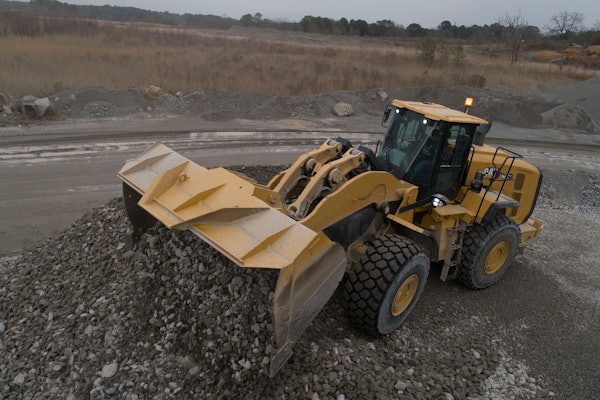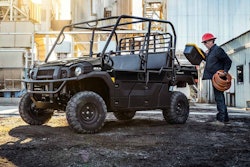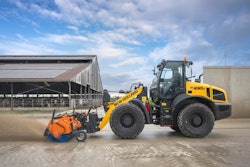If there’s one message John Deere wants you to get with its two heaviest D-Series excavators it’s this: They are here to compete in the big dog league.
“More” seems a weak verb when you compare the 850D LC and 650D LC with their predecessors, the 800C and 600C LC. The 650D LC, for example, now has an 80-metric-ton-class undercarriage and is 15 percent larger than the 600C LC. And the 850D LC is 9 percent larger than the 800C, growing from 168,540 pounds to 185,500 pounds. Both machines, aimed at heavy construction and quarry jobs, carry the heft necessary to complete these projects with ease, says Matt Hendry, product consultant, excavators and ADTs, John Deere.
Balanced strength
“The weight is balanced throughout the machines, rather than just on the front and back ends,” Hendry says. “They really scoot for being such big guys and they don’t porpoise.” The machines increased in overall size and digging power so much that the 600C LC and 800C booms, sticks and buckets cannot be used on the D-Series machines.
Three internal boom bulkheads, one located just behind the stick pin, add rigidity and strength. Deere also uses bulkheads in the stick, contending they offer better strength than using thickened side panels. Deere buckets are designed with shimming adjustments to reduce noise and improve life. And Deere is continuing to use D-frame side channels, citing their durability. Starting in May, the company will offer an optional removable counterweight system.
Controllability equals predictability equals productivity
But none of this new heft was gained at the expense of the excavator operator’s mantra: controllability. “The controls are going to sell these machines,” Hendry declares. “The operators I know – and I used to be one – prefer pilot controls over electro-hydraulic controls, simply because they give you more feedback. We call the controllability of these controls predictability. There’s no abrupt movements. Now add speed to that controllability and your cycle times get better.”
The two models use Deere’s Powerwize III engine hydraulic management system for crisp, responsive hydraulic power. The system is designed to optimize the flow rate for whatever function you’re using. “For example, the boom down is almost twice as fast as the 800C,” says Hendry.
THE 850D LC’s arm force increased 23 percent, bucket force increased 25 percent and lifting forces increased by 11 percent from its predecessor. “There’s a dramatic difference in what it will lift,” Hendry says.
The electronic Isuzu engine in both machines is capable of 550-plus horsepower (the 450D LC, 650D LC and 850D LC share the same fully electronic engine model). The 650D LC is rated at 463 horsepower and the 850D LC at 532 horsepower (see chart on page 26 for more specs).
Isuzu achieved Tier 3 emission standards with a standard turbo charger and cooled exhaust gas recirculation. “Standard turbos are familiar to the people in the shop,” Hendry says, “plus they’ve got proven dependability.”
The doors to service
Deere eased the service requirements on both machines by putting everything on the left side. This includes the cab air filter, which slides in and out of a compartment mounted on the outside of the cab door opened by the ignition key. “The filter used to be behind the seat, and you’d have to lift it out and bring it over the seat,” Hendry says.
The service door immediately behind the cab opens to a roomy compartment that contains the optional ball-valve control pattern changer, giving operators easy access to the switch.
To get to the engine, travel the standard left-hand side “Deere walk” to the second service door behind the cab: this is your gate to an interior service walkway that not only gives you access to the engine, but also the side-by-side hydraulic pumps, which are well protected in the interior of the machine. The round hydraulic tank with only one weld – as opposed to a tank with four corner welds that can vibrate and come apart – is also located in this area.
Electro-hydraulic, on-demand cooling – which saves fuel, reduces noise and pre-screens debris – also has a reversing option that can be operated by a switch in the cab. The reverse option speeds up the fan to full speed, brings it to a stop, then spins it backwards full speed for 30 seconds. The new fan reduces in-cab noise levels from more than 74 decibels down to 67 decibels.
Room with a view
The cab, common to all D-Series excavators, is 3 inches longer on the floor than the C-Series cab. The operator’s seat moves independent of the controls and has 10.5 inches of adjustment. Shorter-joystick, pilot-operated controls offer reduced efforts and travel with no hard throws. The cab comes standard with an air suspended and heated seat.
“One operator told me, ‘I don’t feel claustrophobic in this cab,'” Hendry relates. “He had size 15 boots and still he was able to slide his feet behind the pedals.” He says the extra foot space becomes even more of a comfort issue when those with longer feet reverse the machine. “Now you can slide your feet back and use your toes instead of your heels and you have more control,” he says.
The cab has 47 percent more right-hand window glass and a larger roof-hatch area glass than the C-Series cab. The cab sits about a foot closer to the front for better visibility to the trench. The right side window drops down through the console so you can have a clear view to the right idler with just a glance, important when you’re digging deep to the front of the machine. “You also have a clearer view of what’s going on when you’re truck loading,” Hendry says.
The color LCD in-cab monitor is programmed for 24 languages. It gives operators maintenance monitoring, diagnostic messages, attachment flow settings and system information. Since Deere noted what operators are comfortable with, the monitor presents information in digital representations of gauges.
From the monitor you can program and control up to four attachment flow settings. If you have two different types of hammers, for example, you could program and store each of their flow requirements. Then when you use a particular hammer again, you can simply switch the settings on the monitor.
In addition, there’s plenty of storage space carried over from the C-Series, including an area behind the seat that will hold a small cooler and a hot/cold beverage compartment.









